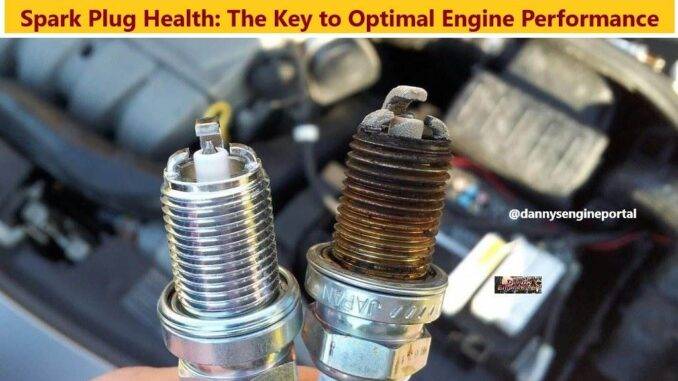
Spark plug health, on today’s engines is very important, and if ignored, can cause serious problems.
So, it stands to reason that, weak or bad spark plugs, are a big cause of concern.
Spark plug health today, is mostly overlooked, because of long life spark plugs. But, there is a risk, if the spark plugs are ignored for too long.
First, keeping track of your spark plug health, is easier than you think. And, if you do need to replace them, you’ll see a apparent difference in your engines performance. As, the engine will run smoother and faster. And, the vehicle will have better acceleration. Furthermore, you may also notice an improvement in fuel economy.
Normal Wear And Tear (On a Healthy Engine)
Spark plugs don’t last forever, even if your engine is in perfect condition. The two biggest reasons are:
1. Spark Plug Deposit Buildup:
When deposits form on spark plugs, it can lead to pre ignition of the fuel.
That means a jerky, and unreliable supply of energy for your vehicle. As a result of, poor spark plug health.
2. Expanding, Harder To Jump Gap:
When a spark plug ignites, it has to travel across a gap of space. Consequently, in order provide the right level of combustion, at the right moment. However, as spark plugs age this gap widens, as a result of extreme temperatures, debris and normal wear and tear. Then, if the gap is too far apart, combustion will be erratic or ineffective.
As the electrodes wear, the voltage required to fire the plugs, continues to go up. And, will eventually lead to engine misfires. And, possible damage to the ignition coils and/or spark plug insulator boots. Then, the (OBD) system will detect ignition misfires and turn on, the Check Engine light (CEL).
Spark Plug Life Span (Healthy Engine)
Most spark plugs have a factory service interval of, 100,000 miles. Although, some may be as much as, 120,000 miles.
Long life platinum and iridium spark plugs, will typically last up to, 100,000 miles or longer. But, only if the engine isn’t using oil or doesn’t spend a lot of time idling.
What Can Shorten, Spark Plug Life Span
Any or all, may be the cause:
- Oil in the Combustion Chamber.
- Improperly Gapped Spark Plugs.
- Carbon Build Up.
- Overheating.
- Mechanical Engine Damage.
Spark Plug health, can be shortened, by frequent short trip driving and idling. Including internal engine problems, that increase oil consumption, (such as worn valve guides or piston rings).
What Are The, Early Failure Warning Signs
Symptoms of bad spark plug health, can include:
- Reduced Gas mileage.
- Lack of Acceleration.
- Hard or Not Starting.
- Engine Misfires.
- Rough Engine Idle.
Spark Plug Replacement, Caution
Replacing spark plugs at 100,000 miles, can be a problem on some applications. When a spark plug has been in the cylinder head for that many miles, problem happen. Because, carbon and corrosion, can make them difficult to remove.
So, there is a risk of damaging the threads in aluminum cylinder heads. Many spark plugs, have nickel plated threads on the plug shell. This helps to prevent corrosion, between the steel threads on the plug, and the aluminum threads in the cylinder head.
Some spark plugs have a black oxide coating on the shell, to inhibit corrosion. But, it’s not as effective as a nickel coating. Plain uncoated spark plugs, offer no corrosion resistance at all, when installed in aluminum heads. Dissimilar metals can react over time, causing the spark plug, to stick in the head.
The use of anti seize compound on spark plug threads, is not recommended for two reasons:
- Anti seize acts like a lubricant, which increases the risk of over tightening the spark plug. As a result, damaging the threads in the cylinder head.
- It can contaminate the electrode, causing the plug to foul and misfire. Spark plugs should be installed dry and tightened to specs.
What Type Of Spark Plug Should I Use, For Best Spark Plug Health
The best guide is the manufacturer’s recommendation for your vehicle. Because, this particular service varies, from brand to brand and model to model.
In general, it’s best to replace spark plugs, as part of preventative maintenance, based on manufacturer’s specs. This can help save you from costly repairs. Because, driving with misfiring spark plugs, could put undue stress on your vehicle’s catalytic converter, “the engine’s exhaust cleaner”.
It’s during the last 20% of a spark plugs life, that misfires and incomplete combustion occurs most frequently. So, changing them before you hit that last stretch, can save you money, time and frustration.
Yes, today’s spark plugs can be expensive. And, you see that when you pay for them. But, the savings in fuel and related failures can far exceed that price, during the life of new spark plugs.
Conclusion
As your car gets older, you may need to replace the spark plugs, more frequently. This is not a difficult project, but it can easily appear, tricky to the newbie. If you are starting to experience a loss of power, poor fuel economy, misfires, rough idling, etc. Most likely, it may be due to worn out spark plugs, affecting spark plug health.
So, your spark plug health, can provide valuable information about your vehicle’s performance. And, can even predict potential problems. Learning how to read a spark plug is, quick and easy. The reading of a spark plug involves, evaluating the condition and color of the tip of the spark plug.
Head off small problems, before they get out of control !
BY DANNY BENDER




